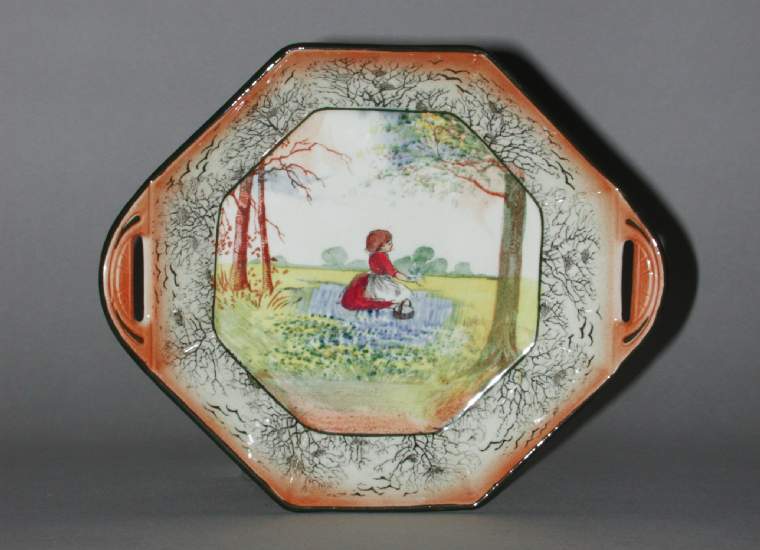Current Location: In storage
Titles
Painted dish
Maker(s)
Factory:
Royal Doulton
Entities
Categories
Description
Octagonal earthenware dish, transfer-printed in black and painted underglaze in polychrome with a little girl seated in a landscape
Cream earthenware, painted in blue, green, yellow, dark pink and brown, over small central transfer in black, and in dark green enamel, Octagonal with integral semi-circular handles on opposing sides, sloping sides and flat base. In the middle, a painting of a little girl with a basket, seated in a field with a tree on the right and two on the left; on the sides, the tops of trees and rooks sketched in brown. There is a narrow green line round the scene and a wider green on the rim. The underside is unpainted and glazed.
Legal notes
Given by David Scrase, Keeper of Paintings and Drawings.
Measurements and weight
Height: 3.8 cm
Height: 1.5 in
Width: 19.6 cm
Width: 7.75 in
Acquisition and important dates
Method of acquisition: Given
(1985)
by
Scrase, David E.
Dating
20th Century
Circa
1930
CE
-
Circa
1935
CE
Note
Doulton, founded c.1815, originally made utility ceramics, stoneware jugs and ornamental bottles. Decorative stoneware and architectural terracotta were introduced at Lambeth in the mid 1860s, using a wide range of techniques and decorative treatments in producing both unique, artist-signed, and limited edition pieces. The Burslem factory opened in the 1880s, producing earthenware and bone china, including dinner services and other household items. In 1901, Edward VII granted the Royal warrant to the factory.
The dish perhaps comes from a nursery rhyme series, and may have been part of a dinnerware or tea set. Doulton produced a variety of series ware, from the early twentieth century, usually decorated using a 'print and tint technique' where the outine was printed onto the piece and then colours filled in by hand. The date mark indicates that the body is earthenware and the design was probably introduced in 1914. However, the factory mark on this dish is recorded only from c.1923, and was in general use from 1932, suggesting that this example was probably made in the 1930s.
School or Style
Art Deco
People, subjects and objects depicted
Components of the work
Decoration
composed of
enamel
Materials used in production
Glaze
Earthenware
Techniques used in production
Moulding
: Cream earthenware, transfer-printed in brown and black and painted underglaze in blue, green, yellow, dark pink and brown and in dark green enamel.
Inscription or legends present
Inscription present: Factory logo: rosette with ‘MADE IN ENGLAND /ROYAL DOULTON ENGLAND’ with crown surmounted by lion above. Printed in black.
- Text: MADE IN ENGLAND /ROYAL DOULTON ENGLAND
- Location: On base
- Method of creation: Printed in black
- Type: Mark
- Text: D 3812/1
- Location: On base
- Method of creation: Painted in brown
- Type: Mark
References and bibliographic entries
Identification numbers
Accession number: C.25-1985
Primary reference Number: 73650
Stable URI
Audit data
Created: Saturday 6 August 2011
Updated: Tuesday 30 April 2024
Last processed: Wednesday 14 May 2025
Associated departments & institutions
Owner or interested party:
The Fitzwilliam Museum
Associated department:
Applied Arts




